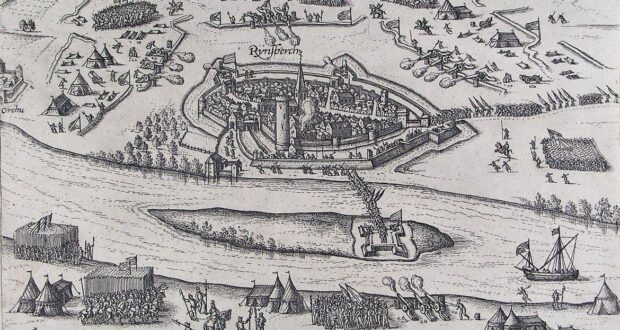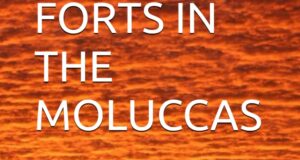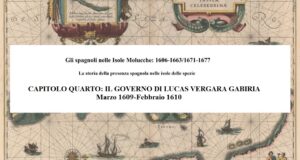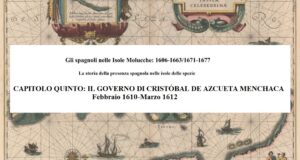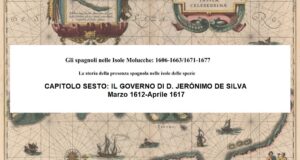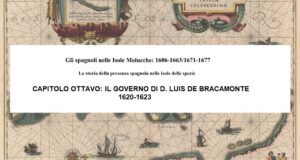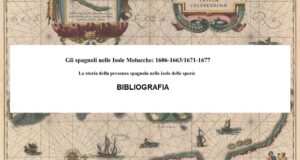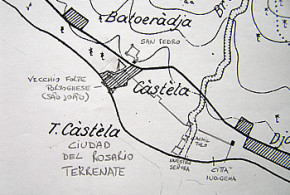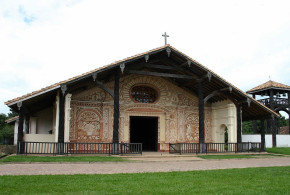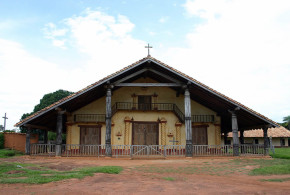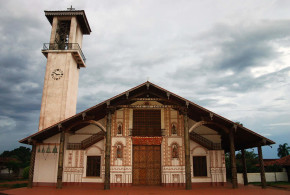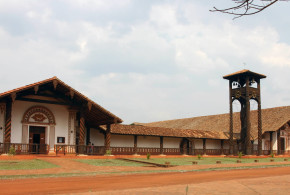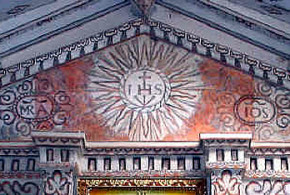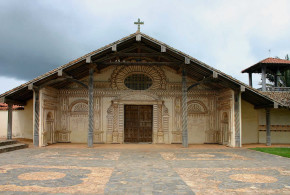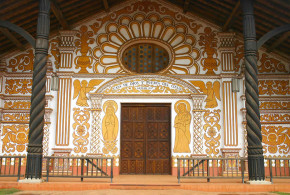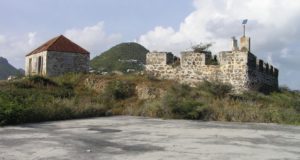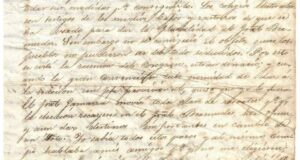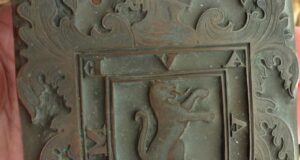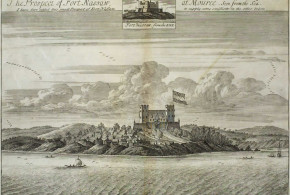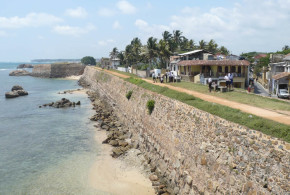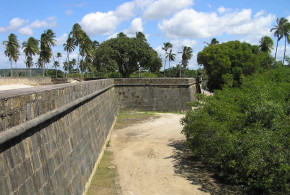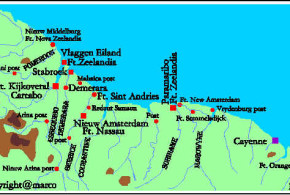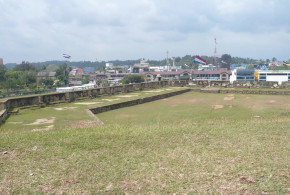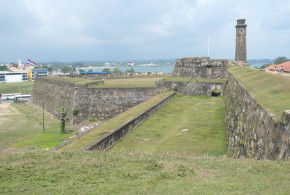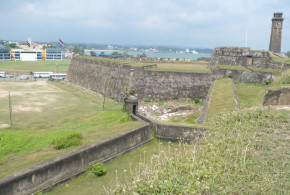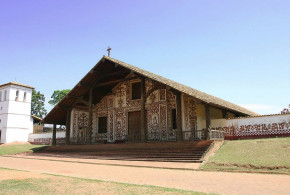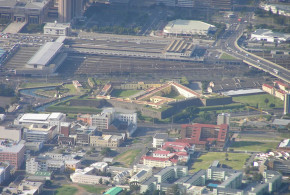This post is also available in:
![]() Italiano
Italiano
Written by Marco Ramerini – 2021 (English translation: 2023)
General Index
AROUND EUROPE p. 3
ARAGON, ITALY, FRANCE p. 3
FLANDERS, FRISIA, GELDRIA… p. 4
THE RETURN TO SPAIN p. 7
IN THE PHILIPPINES AND THE MOLUCCAS p. 10
THE CONQUEST OF TERNATE p. 10
THE FIRST BATTLE OF PLAYA HONDA p. 11
PERMANENCE IN TERNATE p. 11
THE WEDDING AND THE ENCOMIENDA IN THE PHILIPPINES p. 15
THE “SOCORRO” IN TERNATE p. 16
CONTRAST WITH DON JUAN DE SILVA p. 18
THE SECOND BATTLE OF PLAYA HONDA p. 20
THE LAST YEARS IN THE PHILIPPINES p. 22
IN MEXICO p. 24
THE APPOINTMENT AS GOVERNOR OF TERNATE p. 26
ESTEBAN DE ALCÁZAR’S WIFE: ISABEL DE ALVARADO BRACAMONTE p. 30
The figure of Esteban de Alcázar is that of a classic Spanish soldier of the years between the end of the sixteenth century and the beginning of the seventeenth century. In my research I have found him in the Moluccas since the conquest of Ternate in 1606. In this study I have tried to reconstruct the salient facts of his life. In the Spanish archives there are some documents concerning him, here I based myself on those that are available online through the excellent service PARES – Portal de Archivos Españoles. In one of them, dated 16221, it is indicated that he is 44 years old “y es de hedad de quarente y quatro anos poco mas o menos”, so presumably Esteban de Alcázar was born in 1578. This would bring the age of the beginning of his military career, which occurred in 1592, to only 14 years old.
AROUND EUROPE
ARAGON, ITALY, FRANCE
According to his memoir presented in the 16172, Esteban de Alcázar began serving the king of Spain in 1592. In this year he began his service in the army of the king of Spain in the company of Juan Pardo de Rivadeneira in the “jornada de Aragon“. These are the so-called “Alteraciones de Aragón” which took place between 1591 and 1592. These are the events that took place in Aragon during the reign of Philip II of Castile and I of Aragon: A series of conflicts that shook the kingdom and culminated in direct confrontation between the Aragonese institutions and the king.
In the following years, Esteban de Alcázar’s wanderings around Europe began. Initially he had moved to Italy where he served on the site of “Vicaras”3 in Piedmont. From here he had passed into Savoy and Burgundy, where he found himself at the site of “Besu”4 and in the clash with the king of France at “Fontana Francesa (1595)y Desguaso de Guy”5 and on all other occasions which were offered in that war until peace was made between France and Burgundy.6 The Battle of Fontaine-Française, a Burgundian town located 35 km north-east of Dijon, took place on June 5, 1595 between the forces of King Henry IV of France and the troops of the King of Spain and the Catholic League commanded by Juan Fernández de Velasco and Charles of Lorraine, Duke of Mayenne, during the eighth and last war (1585-1598) of the French Wars of Religion. The battle ended in a victory for the French king which marked the end of the Catholic League.
FLANDERS, FRISIA, GELDRIA…
He then passed to Flanders where he served in the company of Ynigo de Otaola. Then he was reformed and participated in the siege of Calais (1596) where in the taking of one of the quarters of the city in a skirmish he was wounded in the thigh by a musket shot.7 The Siege of Calais of 1596, took place between 8 and 24 April 1596, during the Franco-Spanish War (1595-1598). The siege ended with the capture of the city, after a brief siege by the Spanish Army of Flanders commanded by Archduke Albert of Austria, Governor General of the Spanish Netherlands. The French troops barricaded in the citadel of Calais resisted for a few more days, but on April 24, the Spanish troops led by Don Luis de Velasco y Velasco, Count of Salazar, attacked and conquered the fortress, obtaining a complete victory.
In another successful siege by the Spanish, the taking of Huedenen or Huelt8 (the town of Hulst), Esteban de Alcázar, while trying to block the troops sent to help the besieged city was wounded in the arm.9 The siege of Hulst, a Zeeland city located 25 km west of Antwerp, took place between mid-July and August 18, 1596. The Spanish troops led by Archduke Albert VII of Austria (1559 – 1621), after a short siege, captured the city on August 18, 1596.
In the enterprise of Amiens, Esteban de Alcázar was one of the first who arrived at the city gate and who entered the walls. For this the king granted him “tres escudos de bentaja”. In this case we are referring to the feat carried out on March 11, 1597, when the Spaniards attacked the besieged city by surprise: The soldiers of Count Pedro Henriquez de Acevedo y Alvarez de Toledo Count of Fuentes, disguised as peasants, presented themselves in front of the gates of the walls with walnuts and apples. The starving people of Amiens opened the gates and the Spanish entered and took control of the city. Esteban de Alcázar served in this city throughout the subsequent siege placed on the city by the King of France, Henry IV with the assistance of English troops, a siege which lasted about six months. Esteban de Alcázar remained to defend the city until the definitive surrender to the king of France. The Spanish governor of Amiens surrendered on September 25, 1597.
After this event he moved to “Frisia” where he took part in the conquest of Rimberge (Rheinberg) and Dutcomen (Doetinchem) as well as other battles on the island of Bombol (Bommelerwaard), where he participated in the construction of the “Fuerte de San Andres”. 10
What is referred to in the documents as the conquest of Rheinberg, which is a city in North Rhine-Westphalia, Germany, is probably the reconquest11 of the city which took place in 1598 by the troops of Francisco Hurtado de Mendoza. This siege took place from 9 to 14 October 1598, during the Eighty Years’ War, and ended with the surrender of the city to Spanish troops. The capture of Doetinchem, a Dutch city in Guelders, took place on November 8, 1598.
In April 1599, the Spanish army, commanded by Francisco Hurtado de Mendoza, which occupied part of Gelderland, was ordered to mount an offensive against Bommelerwaard, a district of Gelderland north of Den Bosch. In May 1599 the Spanish invaded the island of Bommelerwaard and put the town of Zaltbommel under siege. On 13 June after Maurice of Orange’s troops intensely shelled the Spanish camp, the Spanish were forced to abandon the siege of the city. The Spanish army however moved to the eastern part of the island of Bommelerwaard where the construction of a formidable fortress began at the eastern end, facing the island of Voorn west of Heerewaarden. This fort was called San Andres, and our Esteban de Alcázar also took part in the construction of this fort.12
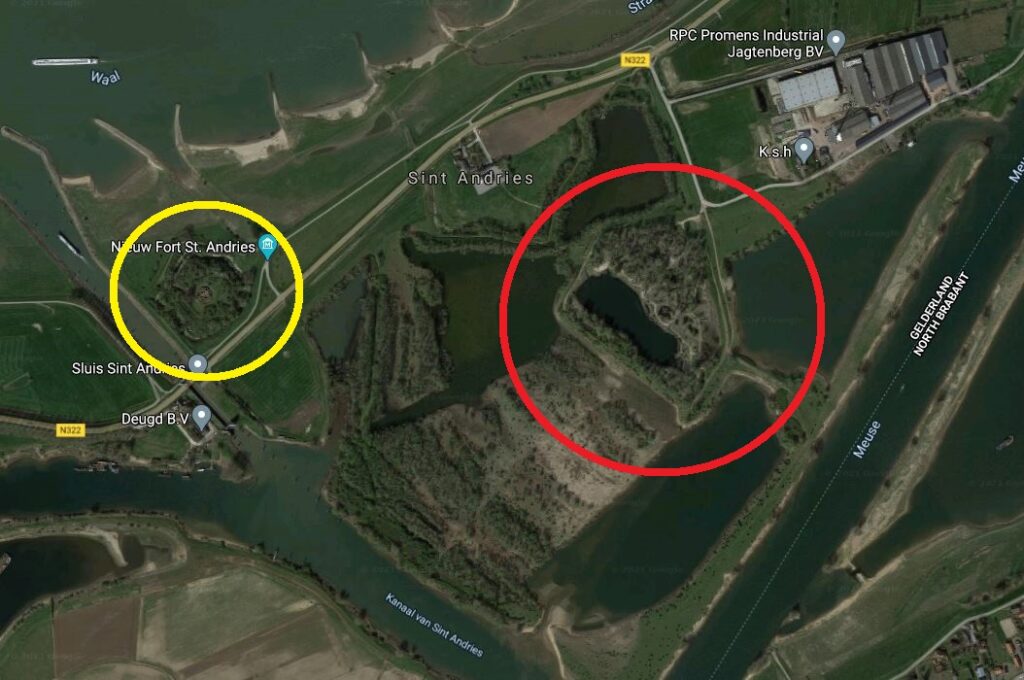
The fort built in 1599 by the Spanish was in the shape of a pentagon, and was strategically located to control the River Waal, which flowed north of the fort, and the River Meuse (Maas), which flowed south of the fort. The five bastions of the fortress were named by the Spaniards: Austria, Burgau, Saxony, Aragon and Velasco. A chapel was also built inside the fort. The fort remained in Spanish hands until May 1600. The fort’s few remains (not to be confused with the remains of the nearby and newer (1810) Nieuw Fort St. Andries which is 600 meters away and is much smaller) are still visible today. Satellite images clearly show the shape of the ancient fort.

THE RETURN TO SPAIN
After fighting throughout Europe, Esteban de Alcázar was given leave to return to Spain. He was sergeant major and ensign of Captain Juan de Peña Garay until by order of the King of Spain his company was reformed. On other occasions he was in the service of Don Juan de Beamonte y Navarra “… por reformacion dejó La Gineta de sargento”.13 In another document it is clarified that he served as a sergeant of Captain Don Juan de Beamonte y Navarra in the “Armada Real del mar Oceano“. Then with the galleons of the “Armada Real della Guardia della Carrera de las Indias” he was in the Indies as sergeant and ensign of Captain Juan de Peña Garay, from here he then passed to New Spain. In New Spain, in 1605, the viceroy, the Marquis de Montesclaros,14 appointed him captain of one of the companies going to the Philippine Islands for the “rrecuperacion de las fuerzas de Terrenate”.15 He served with his company until the Villa de Arevalo16 when the governor of the Philippines Don Pedro de Acuña reformed it.
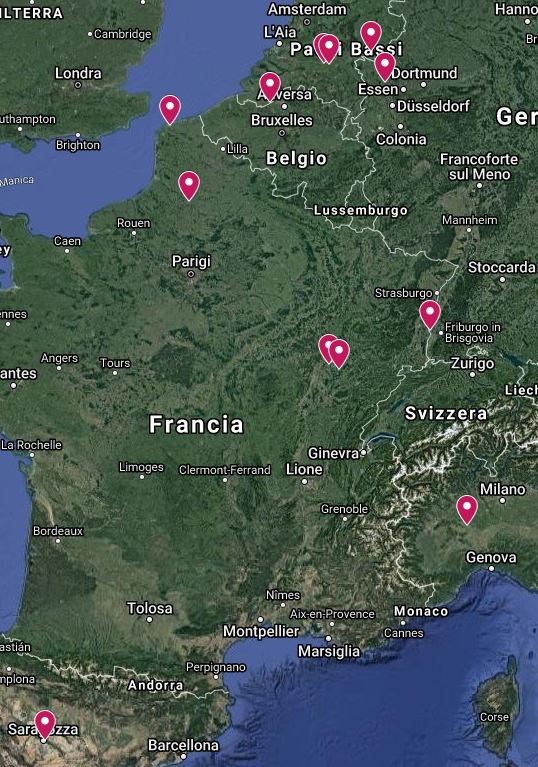
IN THE PHILIPPINES AND THE MOLUCCAS
According to some documents, probably shortly after arriving in the Philippines, Esteban de Alcázar must have had some problems with his superiors because he was imprisoned by order of Jhoan (Juan) de Esquivel, ‘maestre de campo‘ of the Spanish army infantry who had to help Acuña in the Ternate enterprise. In a document dated November 26, 1605, informs that Captain Esteuan de Alcázar, one of the captains of the tercio of Esquivel “esta preso por mi hordem y por esto y estar la dicha compania sin alferez (conuiene?) que aya persona que en el inter la gouerni” therefore he appoints the ensign Gregorio de Vidaña to govern this company ad interim. Also testifies to the same thing Pedro de Acuña, governor and captain general of the Philippines: “...estando presso el Capitan Esteuan de Alcázar sobre cierta caussa que contra el se hizo…” according to Acuña’s testimony, Vidaña remained in the government of the Alcázar company for more than three and a half months.17
THE CONQUEST OF TERNATE
Alcázar in 1606 participated in the conquest of Ternate without assignment and at his own cost. Then due to the death of Christoual de Leon, who was captain of the artillery, Esteban de Alcázar was appointed in his place “por la mucha esperiencia que tenia dela guerra“, with this position he served “sin soldo” during the conquest of Ternate, in which he served “con cuidado y diligencia” and “con entera satisfacion”. Then he returned to Manila with Governor Acuña.18
After the death of Acuña, during the government of the Audiencia19, in 1607, following the news that eight Dutch ships had arrived in Ternate, Alcázar was sent to the Moluccas as head of the “almiranta” ship of the “socorro” and captain of infantry. In this case, despite the attempt of two Dutch ships to capture the “socorro“, the Spaniards managed to reach Ternate.20
THE FIRST BATTLE OF PLAYA HONDA
Alcázar then returned to Manila where he participated, in 1609, with the position of sergeant major, in the army of the new governor Don Juan de Silva21 who fought against the Dutch in Manila. A Dutch fleet under Vice-Admiral François Wittert besieged Manila for five months, starting in 1609. Alcázar also fought with the Dutch fleet in the battle, known as the First Battle of Playa Honda, which resulted in the capture of three ships of the Dutch fleet. The ship “Capitana” and the ship “Almiranta” were captured, while another ship was burned.22 The first naval battle of Playa Honda took place on April 25, 161023 and in two hours of fighting the Spanish routed the Dutch fleet formed by 4 boats, capturing the ships Amsterdam (700 tons) and Valk (a 140 tons jacht), while another jacht of 140 tons, the Arand, was also captured and burned it.24 The fourth Dutch ship fled after the battle was over. The Spanish had 153 killed and 70 wounded, while the Dutch had at least 85 killed and 120 of them taken prisoner by the Spanish. In addition to the two ships the Spanish captured 70 guns, ammunition and richly valuable merchandise. Dutch fleet commander Admiral François Wittert was also killed in the battle.
PERMANENCE IN TERNATE
In 1611 he returned to Ternate, at his own cost, together with the expedition commanded by Juan de Silva. He managed to enter the fort of Malayo with a stratagem in order to have the opportunity to see and study closely the defenses set up in the fort by the Dutch. He was in fact commissioned by Juan de Silva to deliver a letter to the Dutch in the fort of Malayo, where the ransom of prisoners captured by the Spaniards in Manila was being negotiated.25
By decision of Juan de Silva, to Esteban de Alcázar and Pedro de Heredia were ordered to bring the prince of Ternate, Cachil Siran, to Jilolo. On this occasion the village of Xilolo submitted to the Spaniards above all thanks to the presence of the prince of Ternate. Once the Jilolo post was occupied, the Spanish learned from the people of Jilolo that the people of Sabugo often raided Jilolo. In anticipation of an assault on this village, Alcázar together with Luca de Vergara Gabiria and Pedro Zapata, was among those who went to recognize the “boca del rio de Sagugo (Sabugo)”.26 Thus it was decided to assault Sabugo. Fernado de Ayala also arrived in Jilolo to reinforce the Spanish forces with 50 men, the assault on the village was made by land.27
During this period he remained in Ternate where he served the king of Spain for three years at his own cost,28 until 1614. In these islands, together with the Prince of Tidore, he rescued the ship “Santana” probably the Santa Ana ship “almiranta” of the “socorro” which arrived in Ternate in the first months of 1612. This ship had been attacked by a Dutch ship, but the prompt intervention of the Spaniards managed to save it from the enemy.29
In March 1612, he distinguished himself in the capture of a Dutch galley (actually it was a galley that the Dutch had taken from the Spanish: “hauiendo tomado el enemigo una galera nuestra y viniendo con ella a tomar otra frigata”)30 who had attempted to capture a Spanish frigate anchored under the walls of the city of Ternate. The battle was against Captain ‘Escoto‘ who had arrived with a galley to attack a frigate and a ship in the port of Ternate, and before 6 enemy ships and 6 enemy boats could help the Dutch, Alcázar attacked the enemy galley with a boat, while another captain (Juan Gutierrez Paramo) attacked it with a “caracoa“, the joint action forced the Dutch ship to surrender, in the clash 40 Dutch were captured while more than 50 Dutch died. With this galley taken from the Dutch, the Spanish later succeeded in capturing the vessel ‘Gouda’.31
Gerónimo de Silva also tells us about this episode in his letter to Don Juan de Silva dated May 2, 1612: using a “caracoa y una chalupa” Captain Juan Gutierrez Paramo and the sergeant major Esteban de Alcázar with some Spanish soldiers attacked the Dutch galley and in front of the port of Ciudad de Rosario32 after more than two hours of fighting they managed to defeat their enemies killing many Dutch and capturing 43.33
In another letter written to Don Juan de Silva on October 14, 1612, Gerónimo de Silva again mentions Esteban de Alcázar, this time in his words filters a polemical note about the character of Alcázar: “El capitan Alcázar está ahi muy bien, aunque estuviera mejor mas léjos, porque su modo é inquietud natural es muy dañoso, y asi no ahy que tratar de su venida aqui, dondesus cartas y relaciones no perdona á nadie de allá ni de acá que es lástima ver con el desenfrenamiento que sin Dios ni verdad se atreve á hablar”.34 From his words it is clear Alcázar’s bad temper that Gerónimo de Silva, between the lines, would gladly send back to Manila.
After the conquest of Marieco35 on the part of the Dutch, Alcázar received the order from Gerónimo de Silva (“conffiando en el valor y esperiencia del ssargento mayor”)36 to assist the king of Tidore to advise him in the defense of his land. So he went to Tidore, where the enemies (Dutch and Ternatese) were besieging the island with 14 ships and 60 (in other documents it is indicated 45) caracoras, and thanks to his advice the Dutch failed in their intentions. Here reference is made to the events that took place in Tidore in July 1613, in which the Dutch with a large army attacked the city of the king of Tidore, managing to conquer the old Portuguese fort, but failing to conquer the city.37 After a bitter fight the fort was conquered by the Dutch, 46 Spanish soldiers died in the battle.38
Let’s see about this episode and the role of Esteban de Alcázar what else I found. On June 30, 1613, Alcázar was sent by the king of Tidore to Ternate with a letter for Gerónimo de Silva in which the king advised to dismantle the old Portuguese fort for being “tan flaco por ser piedra sobre piedra”. Alcázar and also the “contador” Gerónimo de Almansa on this occasion were sent by the king of Tidore to Ternate to inform de Silva of the bad state of the old Portuguese fort.39 De Silva’s response arrives the next day, July 1, 1613, in this correspondence, de Silva expresses his disappointment with the proposal to dismantle the old Portuguese fort, indeed orders that this fort be reinforced and fortified by Don Fernando Becerra.40
Esteban de Alcázar stayed three years at his own cost in Ternate, then moved on to Manila to give news of the situation in the Moluccas. He remained in Ternate until 1614, when at the request of the governor of the Philippines, Don Juan de Silva, he returned to Manila. Don Juan de Silva called Esteban de Alcázar back to Manila to ascertain the real situation of the Spanish garrisons in the Moluccas.41 The governor of the Philippines Don Juan de Silva, who was preparing a large expedition against the Dutch, also names Alcázar in his orders to Gerónimo de Silva dated October 13, 1613. In this letter it is ordered that Esteban de Alcázar will have to leave with a galley on the 15th March 1614 from Ternate together with Captain Tufiño and proceed to the island of Siao, and there await the orders of the governor.42 In a subsequent letter written on November 30, 1613 Alcázar is mentioned again, here called “Valcazar” in these new orders the date of departure is changed. Alcázar will have to leave Ternate with a “fregatilla” on February 1, 1614 following the Siao route, Punta de Naso, Manila.43
Another correspondence from Don Juan de Silva to Gerónimo de Silva, dated April 30, 1614, confirms that Esteban de Alcázar had arrived in Manila where he informed the governor of the situation in the Moluccas and of the Dutch forces present there.44
THE WEDDING AND THE ENCOMIENDA IN THE PHILIPPINES
In 1614, after returning to Manila, Alcázar married Dona Isabel de Alvarado Bracamonte, sister of the “licenciado” don Juan de Albarado Bracamonte, “fiscal” of the “Audiencia” of Manila. Following these feats, and on the occasion of his marriage, the sergeant major Esteban de Alcázar received, from Don Juan de Silva, on August 2, 1614, an “encomienda” of half the tributes of the villages of Hagonoy and Calompit. The other half of the encomienda was assigned to Don Fernando Centeno Maldonado45, that on the same day had married doña Maria de Alvarado, sister of the wife of Esteban de Alcázar. Of both marriages was godfather Don Juan de Silva, who explains to us that he gave to both this encomienda of 2,000 Indians, which is located 4 leagues from Manila, so that the two are rewarded for their exploits in the Moluccas and that they feel obliged to do their duty. At the end of the same document, Juan de Silva proposes for Alcázar the position of head of the Ternate galley “…y el tiempo que ahí estuviere el sargento mayor Alcázar podrá ser cabo de las galeras, ó el capitan don Diego de Quiñones, entre tanto que se viene; y entónces pondrà Vmd. en ella la persona que le pareciere segun lo que en esta parte tengo dicho”.46
As we have seen, in August 161447 Alcázar received the encomienda of the villages of Hagonoy and Calompit from the governor of the Philippines Juan de Silva. This encomienda was confirmed by the King of Spain with the Real Cedula of 25 October 1616.48 This encomienda had belonged to captain and sergeant major Juan de Morones and then on his death passed to his wife dona Ana de Monterrey (who later remarried), but now having also died, the encomienda remained free.49 The two villages of Hagonoy and Calompit are located about 40 km northwest of Manila as the crow flies in the so-called province of La Pampanga, east of the river of the same name. The encomienda is also granted by Don Juan de Silva because “…esperamos continuareis al dicho Real servicio metiendo el socorro que de pressente se esta aprestando para las diches furcas de Terrenate que os hémos encargado de que su Magestad se dara por muy servido”.50
THE “SOCORRO” IN TERNATE
In fact always in the same year (1614), commissioned by Don Juan de Silva,51 Alcázar returned to Ternate at the head of the relief fleet, which was made up of “dos galeras, tres pataches y una fregata” and three infantry companies (another document speaks of two ships, an ‘urca‘, a frigate, two galleys and 3 infantry companies),52 managing to reach Ternate despite the Dutch having tried to block the ‘socorro‘ with 13 warships. This relief was very important for Ternate, in fact the Spaniards had previously lost one relief and half of another.53 The two reliefs that went missing were those commanded by Don Fernando de Ayala and Don Pedro Tellez.54
This “socorro” departed from the province of Oton in October 161455, indeed in a letter written to Gerónimo de Silva dated September 20, 1614, Don Juan de Silva informs us that the “socorro que sale á el presente, me pareció encargarlo á el capitan y sargento mayor Esteban de Alcázar, ansi por ser soldado y tener pràtica en navegaciones, y de buena resolucion, come por estar obligado por muchos caminos á hacer el deber”56 Don Gerónimo de Silva in his letter to Don Juan de Silva dated December 12, 1614, informs us that the “socorro” arrived in Ternate “…á los 9 del pasado” and the happiness and relief was so great he brought to the Spaniards barricaded in the garrisons of the Moluccas. The “socorro” led by Alcázar managed to pass through the Punta de Iloilo eight days before the Dutch army arrived there, and this was thanks to the “…buena solicitud que puso en el viaje”.57 Esteban de Alcázar declares that this task was given to him by the governor only 40 days after he had married “casado” with Dona Isabel de Alvarado Bracamonte second sister of the licenciado Don Juan de Alvarado Bracamonte.58 Despite this, he accepted the risk of the mission that Don Juan de Silva had ordered him, that is, to bring relief to Ternate which was in grave danger. If he had not succeeded in his enterprise certainly Ternate and the other garrisons of the Moluccas would have been lost to Spain. Furthermore, he did everything at his cost, without pay, not accepting the position of head of the “socorro“, this, as we will see below, is also confirmed by Juan de Silva.59
The expedition set sail in October 1614 (according to the instructions, the day of departure was to be October 4), reached Cebu, where Father Colin tells us of a curious episode: Here, lacking a chaplain for the army and having asked for one to the rector of the college, who answered in the negative, the commander of the expedition Esteban de Alcazar, referred to as “soldado antiguo“, practically “kidnapped” the Jesuit father Pedro Martinez, who had boarded a galley to confess the soldiers, suddenly making the boat set sail with the Jesuit on board. The outward journey to Ternate took only 14 days, while the return journey took 64 days, in total the journey lasted 5 months.60
Regarding Esteban de Alcázar in a letter dated November 14, 1614, Don Juan de Silva writes that in 1611 he had offered to participate at his cost in the expedition organized by de Silva to Ternate, the governor confirms that subsequently, Alcázar had remained to serve in Ternate for three years without pay. Furthermore, in the last “socorro” de Silva had appointed him as head of the “socorro” with a salary of 60 pesos a month, but Alcázar wanted to go without salary and at his own cost “… considerando las necesidades de la real caxa de que yo hice particular estimacion”.61
At the end of 1614 (November 14, 1614) Juan de Silva gives an excellent opinion on Esteban de Alcázar: “y por ser …. de talento, capacidad, platica y esperiencia en las cossas de la guerra”. In relation to the last relief in Ternate, Juan de Silva in this document indicates that the relief had left in October 1614 from the province of Oton. For this task the governor had appointed Alcázar because experience was necessary and the “buena resolucion de su persona”. The governor was also impressed by the fact that Alcázar wanted to leave without any salary, even though the governor had offered him the position of chief at 60 pesos a month. At the end of the same document de Silva writes that Alcázar deserves it “la onrra y mrd que fuere servido hacerle ocupandole en officios y puestos de guerra de que me prometo dare toda buena quenta”.62
CONTRAST WITH DON JUAN DE SILVA
On July 3, 1615 Esteban de Alcázar presents a “peticon” to the Audiencia of Manila in which noting the death of Juan Xuarez Gallinato, ‘maestre de campo‘ of Manila, he requests this assignment as a reward for his services.63 The Audiencia of Manila gives a favorable opinion in particular Andrés de Alcaraz and Juan Manuel de la Vega recommend Esteban de Alcázar, as ‘maestre de campo‘ with 3,000 pesos of tribute. However, this recommendation is not signed by the president of the Audiencia, the licenciado Luis Ortiz de Padilla, because he had already recommended someone else for that position. Furthermore, the governor of the Philippines, Juan de Silva, sends a letter (dated August 5, 1615) against the recommendation formulated by the Audiencia for Esteban de Alcázar due to lack of merit. According to Juan de Silva, in fact, the granting of the encomienda is already enough in relation to the merits and services he has performed. Also grant him the position of ‘maestre de campo‘ “seria cossa monstruossa y que aqui caussaria grande espanto y novedad”…”porque no tiene subjeto ni parte para tan grande puesto ni para otros muy menores”. For this position the governor proposes Don Gerónimo de Silva (relative of the governor of the Philippines), current governor of Ternate.64 Considering the character of Alcázar, which appears from the documents consulted, such a letter from the governor of the Philippines must have caused him great resentment. This largely explains subsequent events.
There is an interesting document concerning a lawsuit between the Alcázar and the Governor of the Philippines Don Juan de Silva. According to what I have been able to reconstruct, it concerns Alcázar’s lack of military service during the expedition organized by de Silva to Malacca. Because of this Alcázar was imprisoned. In the case, Esteban de Alcázar, “encomendero de esta ciudad” and on the other “el licenciado Don R.o Goncelz de la Barra.da abogado de la dicha Real Audiencia”. Alcázar had presented the Audiencia with a request before (Gaspar Aluarado?) who was in charge of representing the governor of the Philippines Don Juan de Silva. Alcázar states that he was not a “soldado de soldo del presidio” of the Philippines, but was an inhabitant and encomendero of Manila and was married to dona Ysabel de Albarado Bracamonte and therefore the governor could not imprison him as captain general because he did not have the jurisdiction to being able to do so, not being “soldado de soldo” in accordance with the Real Cédula of November 17, 1607. The governor could not juridically do what he had done, having no reason against him, that is, put him in prison. Alcázar calls for justice.65
On (23?) January 1616 Don Juan de Silva responds to the cause made by Alcázar, it seems that Alcázar according to his version fled the call in the port of Cavite, de Silva in fact was leaving on his expedition to Malacca and had called all available soldiers. Evidently the governor considered Alcázar a soldier, but he no longer considered himself a soldier, but a citizen of Manila, married and with an encomienda. On December 21, 1615, a ‘bando‘ was published in which on December 31 all “los apersebitos” had to present themselves in the port of Cavite, “pena de caer […] en malasso” and one “de los apersebitos” was the sergeant major Esteban de Alcázar. He was prosecuted as a transgressor of the ‘bando‘, with his escape he set a bad example for others as well. With the Alcázar’s abandonment of service for the king, de Silva had declared free the half of the encomienda of Hagonoy and Calompit that Alcázar owned.
According to de Silva, Alcázar has incurred the penalty of “malcasso y perdimento” the announcement of his sentence is also made public. On May 11, 1616, Esteban de Alcázar “vizino de esta ciudad“, and the “fiscal” of Manila “el licenciado Don R.o Goncalez de la Barrera“, appear on one side, on this date the cause is declared null and his encomienda of half of Hagonoy and Calompit is returned to Alcázar with all the goods and fruits that he kept before his imprisonment. It is also ordered to restore the good reputation that Alcázar held by making his acquittal public. The governor Don Juan de Silva had in fact died in Malacca on April 19, 1616 and had left a will with a clause in which he indicates that the causes that he had opened against “diferentes personas” are all forgiven so that God forgives me of my sins. The cause in question was definitively closed on 12 August 1620.66
THE SECOND BATTLE OF PLAYA HONDA
Subsequently, being “Alcalde ordinario”,67 he fought in the Philippines against the Dutch at his own cost, on this occasion he participated by bringing a boat (champan) of provisions for him and his companions. On the first day of battle, he burned his face, hands and legs in the fight. The second day of battle had the “proa” under his charge until the Spaniards managed to sink the enemy ship “capitana“. In the engagement the Spanish burned two more Dutch ships, while the other enemy ships fled.68
This naval battle is most likely the so-called Second Battle of Playa Honda. The clash took place on 14 and 15 April 1617 between the Spanish naval squadron commanded by Don Juan Ronquillo and made up of 7 “galeones” and 3 galleys. The “capitana” ship, where Don Juan Ronquillo was embarked, was the “San Salvador” and had on board 46 pieces of artillery and 250 soldiers. The “San Marcos” galleon commanded by Don Juan de la Vega with 42 pieces of artillery and 164 soldiers. The galleon “San Juan Baptista” commanded by Pedro de Heredia with 32 pieces of artillery and 146 soldiers. The “San Miguel” galleon commanded by Rodrigo Agillestigi with 31 pieces of artillery and 138 soldiers. The galleon “San Felipe” commanded by Sebastian de Madrid, with 27 pieces of artillery and 111 soldiers. The galleon “Nuestra Señora de Guadalupe” commanded by Juán Baptista de Molina, with 24 pieces of artillery and 146 soldiers. The “San Lorenço” galleon commanded by Juán de Azeuvdo with 22 pieces of artillery and 44 soldiers. The general of the 3 galleys was Alonso Enriquez, the other two galleys were commanded by Captain Don Diego de Quiñones and sergeant major Don Pedro Tellez. Finally there was a “pataque” by the Portuguese captain Andres Coello.69
According to Manuel de Madrid’s “Relacion…” the Dutch fleet consisted of 14 “galeones gruessos” (while according to other texts there were 10 Dutch ships)70 and various other ships, launches and smaller boats, commanding the fleet it was Dutch Admiral Joris van Spilbergen.
On the first day there was only a small skirmish between the Dutch ships and the Spanish captain ship. The next day the real naval battle took place, in which the Dutch were clearly beaten: in the battle they lost their flagship the “Grote Zon”71 called in the Spanish texts “Sol de Holanda” a 600-ton vessel. The “Grote Aeolus”72 a 320-ton vessel blew apart and sank during the battle. A third Dutch vessel, the “Ter Veere”73 of 700 tons was burned. The other Dutch ships fled. In the battle, the Spaniards only lost the “San Marcos” galleon, probably due to the inexperience of their commander. Despite the victory, most of the Spanish fleet suffered serious damage.74
In October 1617, Alcázar presented a petition requesting an annuity of 4,000 pesos and a government in New Spain. In this document there is his Memorial which lists his services, in particular those performed in Ternate. This documentation is accompanied by a “Letter from Juan de Silva recommending Esteban de Alcázar”, dated Manila, November 14, 1614. Then there is the official information on the merits and services of Esteban de Alcázar (August 3, 1615) and finally the “Summary of Esteban de Alcázar’s services”.75 In this document, witnesses are asked 15 questions. Among the witnesses we find Captain Pedro de Hermua, Captain Francisco de Romanico, Captain Don Juan de Salaçar (Salazar), Captain Don P. Manuel (de Bracamonte), (the ensign Juan de Conbria?), the ensign Juan Montero Criado. A certification from General Gallinato, a certification from Don Pedro de Acuna. The audition in the Manila Audiencia of the captain. Among other testimonies there are also those of the prince of Tidore, Cachil Mayo, of the king of Tidore, Cachil Mole, of Geronimo de Silva and Geronimo de Almansa.
THE LAST YEARS IN THE PHILIPPINES
Subsequently the Audiencia commissioned Esteban de Alcázar to build the galleon “San Andres”, he managed to build it in just four months. He was given the position of head of six provinces. He was named, by Don Alonso Fajardo de Tenza, “alcayde del parian de los Sangleys” “dio residencia del dicho oficio, y fue declarado por buen juez, y merecedor de mayores mercedes.”.76 The Sangleyes were the inhabitants of mixed Chinese and Filipino descent from the Philippines. In 1581 the governor Gonzalo Ronquillo de Peñalosa (1580-1583) formed a neighborhood (Alcaicería) in Manila in which the Chinese lived and traded. This Chinese district, from the beginning was known by the name of Parián, that is the silk market, and in it the Sangleys had their houses and shops, for which they paid a rent to the “cabildo” of Manila.77
In 1620 Esteban de Alcázar was commissioned to make the voyage from the Philippines to New Spain as “almirante” of the ships, with the promise that on his return he would be made general. On the outward journey he had many blizzards and hurricanes “En el viage tuuo muchas tormentas de huracanes continuos, y sin arbol mayor, y mesana, y medio trinquete, auiendo estado çoçobrado, y con diez palmos de agua sobre la carlinga, bolbiò la nao a salvamiento a Manila, y dio residencia, y no resultò cargo contra el” but, in spite of everything, he managed to return the ship safely to Manila.78
In 1623, Esteban de Alcázar had served the King for 33 years and was given permission to come to Spain. In fact, on July 19, 1623, he received a four-year license from the governor of the Philippines to return to Spain. In the handwritten text it is added that the Audiencia of Manila has given the opinion that mercy is given to him with the title of Mestre de Campo of those islands or of “tresmiles tributos en indios”.79 The purpose of his license was to plead an award for his years of service to the king, the license was given to him for 4 years with the “retención” of half of the tributes he enjoyed from the encomienda of the villages of Hagonoy and Calompit.80
IN MEXICO
In April 1626 from Barcelona a Real Cédula extended by one year the time to remain in these kingdoms (New Spain) granted by the governor of the Philippines.81
In 1627, in his “Petición“, Esteban de Alcázar requests a license for another two years to dispose of the goods he has in Mexico and together with this he requests a declaration to continue enjoying the encomienda in the Philippine Islands and a license to take with him all the people he brought. In this document he declares that the license he had received from the governor of the Philippines Don Alonso Fajardo de Tenza, the first license, had a duration of four years. In 1626 he had received a one-year extension. Alcázar complains that he has not had an answer to his numerous requests for benefits for the services he has rendered to the king. So he asks for another two years of leave.82
The following year in May 1627 from Aranjuez another Real Cédula extended the time to stay in New Spain by two years.83 In June 1627 the sergeant major Esteban de Alcázar requests a charter of recommendation so that the viceroy of New Spain and the governor of the Philippines will do him mercy according to his services.84
The many requests presented to the king finally bear fruit, in June 1627 the king sends a Real Cédula to the Marquis de Cerralbo, viceroy of New Spain, in which he recommends Esteban de Alcázar.85 The same recommendation is made with another Real Cédula to Don Juan Niño de Távora, governor of the Philippines.86
At the end of June 1627 there is an information file “Expediente de información y licencia de pasajero” where Esteban de Alcázar asks for the passenger license to return to the Philippines, together with his servant Esteban Lento (Lonto).87
In July 1629, with a Real Cédula, Esteban de Alcázar’s permission to absent himself from the Philippines to attend to his affairs was extended.88 But his stay in Mexico must have extended beyond the terms established by the king. Already in November 1629, another Real Cédula was issued from Madrid addressed precisely to Esteban de Alcázar, resident in Mexico. In this cedula it is indicated that at the end of the license he has to live outside the Philippines, if he does not return to live in those islands, the laws concerning the encomenderos who do not reside in their encomiendas will be respected, considering them as vacant.89 So the King threatens to take away the encomienda.
At the end of September 1629, Esteban de Alcázar requests a certificate of explanations and presents a “Memorial” in which he requests the sending of a new “cédula” in which the one already delivered is inserted, asking which “cédulas” must be performed if after eight years did not return to reside in the Philippines. In this document Alcázar declares to be “en poca salud no sabe si podra bolver a resider”. It seems that the request is unsuccessful, in fact at the end of the document it is added: “Que se declara que se executan las cedulas de su Mag.d. Que hablan contra los encomenderos que no residen ni hazen vezindad en sus encomiendas...”.90
A new “Real cédula” is issued in May 1630, in this document the license to stay away from the Philippines is extended by another year, in the document Esteban de Alcázar is authorized to collect what he would have earned from his encomienda.91
To recap: Alcázar first obtained a 4-year license, then an extension of the license for another 3 years. But despite all these years he received no mercy “…y hallandose muy alcanzado y gastado, y qui no tenia con que sustentarse mas en esta corte se bolbio a embarcar para Filipinas, y en ellas sirvir a V. Mag.d. Y esperar que le hiciesse merced equivalente a sus servicios, y viendo que se le acabava la prorrogacion que V. Mag.d. le auia mandado dar, pidio el ano passado a V. Mag.d. Le hiciesse merced de mandarle prorrogar la licencia que tenia por un ano mas para poder residir en Mexico, y recoger la hazienda que tiene en aquella ciudad, la qual licencia, y prorrogacion le se concedio en 20 de Julio del ano passado la qual no se le ha podido remitir ni otros papeles que espera para el despacho de sus negocios en Mexico, por no hauer hauido flota ni navios de auiso”. On this occasion, he asks for another year of license extension to still reside in Mexico City “dentro el qual tiempo podrò concluir sus negocios”.92
In June 1634 another “Real Cédula” was sent to Sebastián Hurtado de Corcuera, governor of the Philippines, informing him of the license granted to Esteban de Alcázar, which extended by two years the one he had to reside in Mexico City, despite being an encomendero in the Philippines.93
In view of Alcázar’s failure to return to the Philippines and the subsequent loss of the encomienda, requests are starting to arrive from many quarters to replace him in that encomienda. At the end of August 1634, Captain Luis Alonso de Roa, resident in Manila, son of Pelayo Hernández, married to María Arias Girón, daughter of Captain Rodrigo Arias, asked for the “alcaldía mayor” of Tondo and the encomienda, which would remain empty when the general Esteban de Alcázar will leave for Spain.94
THE APPOINTMENT AS GOVERNOR OF TERNATE
In the archive of the Indies of Seville there is a document, a Real Provisión, appointing Esteban de Alcázar as governor of Ternate, it is the “Royal provision that appoints the captain and sergeant major Esteban de Alcázar “alcaide” of Ternate and governor of that garrison, for a period of eight years and replacing Pedro de Heredia. The document is made in Madrid and is dated June 20, 1634. At that time Esteban de Alcázar was in New Spain (Mexico).95
From what happens next it seems that Esteban de Alcázar is not so convinced of spending another eight years of his life in the Moluccas. In fact, after his appointment dated June 1634, there are two other documents that address the question: these are two “Real Cédula“, written in Madrid on October 3, 1634. The first document is addressed to the maestre de campo Pedro de Heredia, ‘alcaide‘ of the fortress of Ternate and governor of said garrison. In the document, Heredia is informed that Francisco Suárez de Figueroa y Acevedo has been nominated to fill the position of governor ‘ad interim‘ in case Esteban de Alcázar, who was nominated for this post, does not accept it.96 The second document is addressed to the governor of the Philippines, Sebastián Hurtado de Corcuera. In this case, the King orders that, in the event that Esteban de Alcázar does not want to accept the position of ‘alcaide‘ and governor of the fortress of Ternate, for which he was nominated, Francisco Suárez de Figueroa y Acevedo is nominated ad interim in his place.97
A year and four months later the issue still does not seem settled. In fact there are two other documents, both written in Madrid and dated January 22, 1636, which authorize Esteban de Alcázar to return to Spain in the event that he renounces the government of Ternate. The first document, which is addressed to the Marquis of Cadereyta, viceroy of New Spain, informs us that Esteban de Alcázar is a resident of Mexico, but holds an “encomienda” in the Philippines. The King grants to Alcázar the license to come to Spain, in case he does not accept the position of ‘alcaide‘ and governor of the fortress of Ternate. While if he accepts it he must move immediately to Ternate.98 The second document is the Real Cédula which grants license to Esteban de Alcázar, resident in Mexico and encomendero in the Philippines, to come to Spain for a period of two years, thus extending the four years previously granted. Here too it is reiterated that if he decides to go to Spain, he must first leave his office as ‘alcaide‘ and governor of the Ternate fortress.99
From these documents emerges a great indecision on the part of Esteban de Alcázar on what to do. Destiny, however, as we will see below, will choose for him, and it will be neither of the two things envisaged.
In the Archivo Histórico Nacional there is one last interesting document, dated January 14, 1636, it is a letter from General Esteban de Alcázar who recounts his stay in San Cristóbal, a town located about 20 km as the crow flies from Mexico City, because he was wounded in the hand. “Y lunes 14 del corriente, saluendo de la Venta de Carpio100 Camino de Otumba101 se parò frontero del coche un conejo e me aper para tirarle y me revento el cañón y llevo el dedo [pulgrorro (?)] y me a lastimado la mano en tal manera que me fue forçoso bolber atras, y en este pueblo de San Christóbal102. E alle un cirujano que me curo y dixo que para reparar mayor daño conuenia no pasar de aqui donde estoy aguardando a Villa Viciosa para que me bea y [sicomucene (?)] boluer a la ciudad o si estando aqui tres o quatro dias podre yr enprosegucion de mi viaje doy aviso a […] para que siendo servido mande lo que pare acerca [….] que se Haga [….] S. Xristoual 14 de Enero de 1636.”.103 Unfortunately, from the document it is not possible to understand whether the journey undertaken was a simple journey around Mexico City or whether he had decided to go to the port of Veracruz to embark for Spain.
This wound, caused by the explosion of the weapon used to shoot a rabbit, will most likely be the cause of his death, which occurred just two weeks after this trivial incident. Esteban de Alcázar who survived decades of battles in every corner of the Spanish empire will probably die of an infection caused by this trivial accident. In fact Esteban de Alcázar dies, according to the death certificate indicated in the “Boletim da Filmoteca Ultramarina Portuguesa“, on January 28, 1636.104 If, as we saw at the beginning of this study, 1578 is really the year of his birth, Esteban de Alcázar dies at the age of 58.
In the Archives of the Indies in Seville there is also a document concerning the attestation of the death of General Esteban de Alcázar. In this document we learn that Alcázar died on January 28, 1636 in the village of “San Xptoual de Ecatepeque”. The document in question informs us that the general died while “estando en el pueblo de San Xptoual de Ecatepeque en las cassas de la comunidad del dicho pueblo, vide muerto naturalmente aloque parecio ael general Esteban de Alcázar que conoci en vida”. His body was buried “en el convento e yglesia del dicho pueblo de la horden de señor San Francisco”. In the document it is added that ”y para que dello conste die el presente en el pueblo de San Xptoual de Ecatepeque (destanuz ?) va España a veinte y ocho dias del mes de henero de mill y seicientos y trienta y seis anos”.105
After the news of his death, in September 1636, General Diego de Ascueta y Menchaca, son of the general and maestre de campo Cristóbal de Azcueta y Menchaca, requests to be granted to him the government of Terrenate, which is vacant at cause of the death of General Esteban de Alcázar.106 The year following the death of Alcázar, in March 1637, the Attorney General of the Philippines, Juan Grau y Monfalcón, writes a memorial in which he requests that due to the death of General Esteban de Alcázar, another person be appointed for the post of governor of Ternate. The procurator asks that a governor expert in military matters be appointed, as was the maestre de campo Pedro de Heredia, who has governed those forces until now and thanks to him they have been maintained. This document is accompanied by the “Certification of the death of General Esteban de Alcázar”, a document I mentioned above.107
After his death among the documents concerning him there is also a request from Gaspar del Hierro, husband of Juana de Alcázar Tello, both residents of the city of Murcia, heirs of General Esteban de Alcázar, asking for the sending “de la ordinaria de difuntos” so that the goods of said general are sent to Spain. Juana de Alcázar Tello is the only legitimate sister of Esteban de Alcázar. This is the text of the document as I was able to read it: “Gaspar del Hierro marido y conjunta [person (?)] de dona Juana de Alcázar Tello de la ciudad de Murcia herederos con beneficio de [vivente (?)] de Esteban de Alcázar hermano [legítimo (?)] de la dicha Dona Juana sin hauer otro que lo sea. Dicen que dicho [General] Esteban de Alcázar viniendo de Filipinas para estos reynos murio en la Nueva Espana en un lugar tres o quatros [legoes (?)] de la Ciudad de Mexico [dexando por sus albauas(?)] a Pedro de Soto [……?] ya Dona Isabel de Alvarado Bracamonte su mujer del dicho Esteban de Alcázar, el qual no dexo otros hjos ni erederos [mas forçosos (?)] que la dicha Dona Juana y para [recoxer (?)] su hazier [lastando (?)] hazer que se traiga a estos reinos. Suppl.a V. Mg. se sirua demandar se le de la ordinaria de difuntos para el [inz (?)] dellos remita la [haz.da (?)] y bienes del dicho general Esteban de Alcázar [aestos reynois (?)] enello reciuerà merced”.108
ESTEBAN DE ALCÁZAR’S WIFE: ISABEL DE ALVARADO BRACAMONTE
Subsequent documents in the Archive of the Indies in Seville concern his widowed wife, Isabel de Alvarado, who requests to keep the rights to the encomienda in the Philippines.
As we have seen, Dona Isabel de Alvarado Bracamonte is the sister of the “licenciado” don Juan de Alvarado Bracamonte, “fiscal” of the “Audiencia” of Manila, who later became “oidor” of Panamá. Her family was originally from Jerez de la Frontera (Cádiz). Her parents were Luis Sáez de Alvarado Bracamonte y de Inés de Salazar, who had already died in April 1607.109 Isabel de Alvarado arrived in Manila in 1609 together with her sister Maria de Alvarado and her brother Juan de Alvarado Bracamonte who had been appointed “fiscal de la Audiencia de Manila“, a long plethora of servants also arrived with them.110 Juan de Alvarado Bracamonte was removed from his post of “fiscal” in the Philippines and sent as “ouidor” to Panama for having proceeded in his office with scandal, passion and greed. His two sisters also appear to be implicated in these allegations. A “Real Cédula” dated February 1619 mentions the two sisters, indicating that Juan de Alvarado Bracamonte, he got his sisters married off and connected with people who had interests in the Philippines who were interested in justice causes.111
But let us return to the events following the death of Esteban de Alcázar. In the May 1637 memorial, Isabel de Alvarado requested the extension of the encomienda license in the Philippines since she is in New Spain, where her husband also died. The value of the encomienda is 600 tributes, and Isabel is willing to pay 500 pesos to extend the license. In the document she declares herself “vidua e pobre” and unable to return to the Philippines. The king grants Isabel a pardon on the basis of the proposed 500 pesos, but Juan Grau y Monfalcón informs in April 1637 that the encomienda had a greater value so that at the end of the procedure, Isabel de Alvarado must pay 800 pesos.112
In July 1637 the “Consejo de Indias” proposes that Isabel de Alvarado, widow of Esteban del Alcázar, receive the rights to enjoy her encomienda in the Philippines while she lived in Mexico, placing a squire in her place and paying 800 pesos. The proposal is accepted.113
In December 1637, the king, with a “Real Cédula” granted Isabel de Alvarado, widow of Esteban de Alcázar, to be able to enjoy for her life the encomienda, located in the villages of Calumpit and Hagonoy, in which she succeeded her husband in the Philippines. The concession is given to her even if she is a resident outside the islands, provided that she puts a squire in this position “…que cumpla con las obligaciones de vecindad”.114
The encomienda of Esteban de Alcázar succeeds in “segunda vida” to his widow Isabel de Alvarado. In February 1638 Antonio Sánchez and Juan de Salinas, of the “Contaduría del Consejo”, send a notice to Juan Bautista Uberoga so that the despatch (to enjoy the encomienda by placing a squire) which must be given to Isabel de Alvarado, widow of Esteban de Alcázar, do not stop.115
His wife, Isabel de Alvarado, later remarried with Bernabé Domínguez Abarca.116 I did not find the wedding date among the scanned documents available on PARES. But there are documents from October 1639 in which they are already married, so it is certain that the woman remarried before this date.
Isabel de Alvarado’s second husband, Bernabé Domínguez Abarca (who is (incorrectly?) called Bartolomé in some documents) was the grandson of one of the “conquistadores” of New Spain. He had served the king in various positions. But he had no “otra cossa con que se sustentar” so he asked the king for mercy to confirm for him too, under the same conditions as his wife, in case she died before him, the encomienda in the Philippines by paying 500 pesos. The request was granted, in October 1639, by accepting payment of the proposed 500 pesos.117
Don Bernabé Domínguez was the legitimate son of Alonso Domínguez “regidor” of Mexico City and of Dona Geronima Osorio his legitimate wife, and paternal nephew of Alonso Domínguez, one of the first settlers of Mexico City and great-grandson (“biznieto“) of Bartolomé Gonzales and fourth nephew (“quarto nieto”) of Juan (Imli?) one of the first conquistadors who came to New Spain with the “Marqués del Valle” Don Fernando Cortes and served the king of Spain in the company of Panfilio de Narvaez, and they went with their weapons, servants and horses all at their cost.118 Bernabé Domínguez Abarca appears to have been “correxidor” of the pueblo of Yaguelica. He was then “alcaide mayor del pueblo y parrido degua y Acocotla”.119
The couple’s request resulted in a “Real Cédula” dated July 1641 in which the king granted Bernabé Domínguez Abarca, a resident of New Spain, the encomienda in the Philippines in case his wife died before him.120
Still on the same subject there is a petition, dated May 1642, by Domínguez Abarca on the encomiendas of Isabel de Alvarado. From what we can read Bernabé Domínguez Abarca requests that the encomienda, which had been placed in the Royal Crown, be returned to him and that he can enjoy it in case his wife dies even if he resides outside the Philippines, since he paid for it mercy. Indeed it seems that “La persona que tenia su poder da las dichas encomiendas, no lo quiso obedecer y por no cumplir la dicha mer.d. Que V. Mag.d. le hauia hecho respondio por su decreto de veinte y uno de Abril de seicentos y quarenta ala peticion que se le presento que dichas encomiendas estauan ya metidas en la Corona Real”. In this document we also learn that the king has granted Bernabé Domínguez Abarca, second husband of Isabel de Alvarado, the grace to enjoy his wife’s encomienda when she dies, despite living outside the Philippines.121
In 1642, a “Real Cédula” was sent to the president and the “oidores” of the Audiencia of Manila, asking them to respect the “cédulas” in which the king granted Isabel de Alvarado to enjoy for life the encomienda she has in the Philippines while residing outside the islands. In the same document it is granted to Bartolomé Domínguez, second husband of Isabel de Alvarado, that if she dies before him, he can enjoy this encomienda in the same way for his life, by placing a squire.122
Regarding the passage of the encomienda to Isabel de Alvarado’s second husband, there are three other documents all dated February 1, 1653. The first is a Real Cédula addressed to Juan de Bolívar y Cruz, procurator (fiscal) of the court of Manila, on the collection of proceeds from the effects of Bartolomé Domínguez Abarca.123 The second document is a registration (asiento) of the sending of the same Real Cédula described above to the “presidente y oidores de la Audiencia de Manila”124 and the third document is the registration (asiento) of the same Real Cédula to the “oficiales de la Real Hacienda de Filipinas”.125
NOTES:
1AGI: “Méritos y servicios: Fernando de Ayala: Filipinas”. Archivo: Archivo General de Indias. Fechas: 1622-07-23. Signatura: PATRONATO,53,R.25, sheet 31
2 Memorial del capitán y sargento mayor Esteban de Alcázar, haciendo relación de sus servicios, especialmente los desempeñados en Terrenate. Pide que se le haga merced de 4.000 pesos de renta y un gobierno en Nueva España. AGI: “Petición de merced de Esteban de Alcázar”. Archivo: Archivo General de Indias. Fechas: 1617-10-16. Signatura: FILIPINAS,37,N.50
3 It could be the locality of Vicara next to Rosignano Monferrato, the latter being called the “sentinella di Casale” due to its strategic position. Also referred to as “Bicaras” and then printed as “Vicaras” in: AGI: MERITOS: Esteban de Alcázar. Archivo: Archivo General de Indias. Fechas: 1623-07-19. Signatura: INDIFERENTE,161,N.81. While it is referred to as “Vicarral” in: AGI: “Petición de merced de Esteban de Alcázar”. Archivo: Archivo General de Indias. Fechas: 1617-10-16. Signatura: FILIPINAS,37,N.50
4 Locality of the County of Burgundy, it could be the town, located along the Rhine, of Breisach today in Germany. Indicated as “Besu” in: AGI: MERITOS: Esteban de Alcázar. Archivo: Archivo General de Indias. Fechas: 1623-07-19. Signatura: INDIFERENTE,161,N.81. While it is referred to as “Bisri” o “Bisu” in: AGI: “Petición de merced de Esteban de Alcázar”. Archivo: Archivo General de Indias. Fechas: 1617-10-16. Signatura: FILIPINAS,37,N.50
5 At the moment, I have not found the current name of this locality, but it could be the town of Arc-lès-Gray or Gray itself, both localities less than 20 km southeast of Fontaine-Française. Indicated as “Desguaso de Guy” or “Disguaso de Grey” in: AGI: MERITOS: Esteban de Alcázar. Archivo: Archivo General de Indias. Fechas: 1623-07-19. Signatura: INDIFERENTE,161,N.81
6 AGI: “Petición de merced de Esteban de Alcázar”. Archivo: Archivo General de Indias. Fechas: 1617-10-16. Signatura: FILIPINAS,37,N.50
7 AGI: “Petición de merced de Esteban de Alcázar”. Archivo: Archivo General de Indias. Fechas: 1617-10-16. Signatura: FILIPINAS,37,N.50
8 Also referred to as “Huelt” and “Hulst” in: AGI: MERITOS: Esteban de Alcázar. Archivo: Archivo General de Indias. Fechas: 1623-07-19. Signatura: INDIFERENTE,161,N.81
9 AGI: “Petición de merced de Esteban de Alcázar”. Archivo: Archivo General de Indias. Fechas: 1617-10-16. Signatura: FILIPINAS,37,N.50
10 This island in the documents is also called “Vonvol”. AGI: “Petición de merced de Esteban de Alcázar”. Archivo: Archivo General de Indias. Fechas: 1617-10-16. Signatura: FILIPINAS,37,N.50
11 Rheinberg had been taken from the Spanish by Maurice of Nassau on August 20, 1597.
12 AGI: “Petición de merced de Esteban de Alcázar”. Archivo: Archivo General de Indias. Fechas: 1617-10-16. Signatura: FILIPINAS,37,N.50
13 AGI: “Petición de merced de Esteban de Alcázar”. Archivo: Archivo General de Indias. Fechas: 1617-10-16. Signatura: FILIPINAS,37,N.50
14 Juan de Mendoza y Luna, 3rd Marquess of Montesclaros (January 1571 – October 9, 1628), 10th Viceroy of New Spain. He ruled New Spain from October 27, 1603 to July 2, 1607. Later he was viceroy of Peru, from December 21, 1607 to December 18, 1615.
15 AGI: MERITOS: Esteban de Alcázar. Archivo: Archivo General de Indias. Fechas: 1623-07-19. Signatura: INDIFERENTE,161,N.81. See also AGI: “Petición de merced de Esteban de Alcázar”. Archivo: Archivo General de Indias. Fechas: 1617-10-16. Signatura: FILIPINAS,37,N.50
16 Arévalo de Iloílo, a Philippine city located on the island of Panay.
17 AGI: “Confirmación de encomienda de Albay, etc. Expediente de confirmación de las encomiendas de Albay y Canaman en Camarines y Catanduanes, a Gregorio de Vidaña. Resuelto, [f] 1620-10-21” FILIPINAS,47,N.38. Blocco 2, Foglio 12, 13.
18 AGI: “Parecer de la Audiencia sobre Esteban de Alcázar”. Archivo: Archivo General de Indias. Fechas: 1615-08-07. Signatura: FILIPINAS,20,R.9,N.57. Vedi anche la “Certificaccion del General Gallinato” fogli 42-43 e quella di “Don Pedro de Acuña” fogli 43-45. in AGI: “Petición de merced de Esteban de Alcázar”. Archivo: Archivo General de Indias. Fechas: 1617-10-16. Signatura: FILIPINAS,37,N.50. For the Spanish conquest of Ternate see: Marco Ramerini “The Spaniards in the Moluccas, 1606-1663/1671-1677” pag. 20-34.
19 That is, during the government of Cristóbal Téllez de Almanza, he was the first Governor General of the Philippines of the Real Audiencia of Manila. Téllez was acting governor of the Philippines between June 1606 and June 1608.
20 AGI: “Petición de merced de Esteban de Alcázar”. Archivo: Archivo General de Indias. Fechas: 1617-10-16. Signatura: FILIPINAS,37,N.50
21 Juan de Silva was the 14th Governor General of the Philippines, he held office between April 1609 and April 19, 1616, the date of his death in Malacca.
22 AGI: MERITOS: Esteban de Alcázar. Archivo: Archivo General de Indias. Fechas: 1623-07-19. Signatura: INDIFERENTE,161,N.81
23 The date of the battle is indicated in some texts as 24 April in others as 25 April, in some Dutch texts as 23 April.
24 J.R. Bruijn, F.S. Gaastra, I. Schöffer “Dutch-Asiatic shipping in the 17th and 18th centuries” Vol. 2 pag. 24-25.
25Probably the Dutch captured at the first battle of Playa Honda.
26 AGI: “Parecer de la Audiencia sobre Esteban de Alcázar”. Archivo: Archivo General de Indias. Fechas: 1615-08-07. Signatura: FILIPINAS,20,R.9,N.57
27 AGI: “Méritos y servicios:Fernando de Ayala: Filipinas. Información de los méritos y servicios del general don Fernando de Ayala. Pasó a las islas Filipinas en 1620 con un navío que se envió desde Nueva España; también obtuvo y desempeñó muchos cargos y comisiones, se halló en la conquista de Terrenate e Ilolo. Manila, 23 de julio de 1622. [c] 1622-07-23” PATRONATO,53,R.25 fogli 27-28. The opinion of: Esteuan de Alcazar can be found in folios 26-31.
28 AGI: “Esteban de Alcázar”. Archivo: Archivo General de Indias. Fechas: 1630. Signatura: INDIFERENTE,2077,N.212
29 AGI: “Parecer de la Audiencia sobre Esteban de Alcázar”. Archivo: Archivo General de Indias. Fechas: 1615-08-07. Signatura: FILIPINAS,20,R.9,N.57
30 AGI: “Petición de merced de Esteban de Alcázar. Archivo: Archivo General de Indias. Fechas: 1617-10-16. Signatura: FILIPINAS,37,N.50
31 AGI: “Petición de merced de Esteban de Alcázar. Archivo: Archivo General de Indias. Fechas: 1617-10-16. Signatura: FILIPINAS,37,N.50
32La Ciudad del Rosario was the town that the Spaniards had built in the southern part of the island of Ternate. For a description of this city see: Marco Ramerini “The Spanish town of Ternate: Ciudad del Rosario or Gammalamma” https://www.colonialvoyage.com/spanish-town-ternate-ciudad-del-rosario-gammalamma/
33 “Correspondencia de Don Gerónimo de Silva” in “Coleccion de documentos ineditos para la historia de España” Vol. 52, 1868, p. 19-20
34 “Correspondencia de Don Gerónimo de Silva” in “Coleccion de documentos ineditos para la historia de España” Vol. 52, 1868, p. 68
35 Marieco in the island of Tidore was conquered by the Dutch in February 1613. See: Marco Ramerini “The Spanish in the Moluccas, 1606-1663/1671-1677” pag. 91-92
36 AGI: “Petición de merced de Esteban de Alcázar. Archivo: Archivo General de Indias. Fechas: 1617-10-16. Signatura: FILIPINAS,37,N.50
37 For a detailed description of these episodes see Marco Ramerini “The Spaniards in the Moluccas, 1606-1663/1671-1677” pag. 94-97
38 AGI: “Petición de merced de Esteban de Alcázar. Archivo: Archivo General de Indias. Fechas: 1617-10-16. Signatura: FILIPINAS,37,N.50
39 “Correspondencia de Don Gerónimo de Silva” in “Coleccion de documentos ineditos para la historia de España” Vol. 52, 1868, p. 134
40 “Correspondencia de Don Gerónimo de Silva” in “Coleccion de documentos ineditos para la historia de España” Vol. 52, 1868, p. 135
41 Colin – Pastells “Labor evangélica: Ministerios apostolicos de los obreros de la Compañía de Jesús en las Islas Filipinas” 1902, pag. 289
42 “Correspondencia de Don Gerónimo de Silva” in “Coleccion de documentos ineditos para la historia de España” Vol. 52, 1868, p. 172
43 “Correspondencia de Don Gerónimo de Silva” in “Coleccion de documentos ineditos para la historia de España” Vol. 52, 1868, p. 182
44 “Correspondencia de Don Gerónimo de Silva” in “Coleccion de documentos ineditos para la historia de España” Vol. 52, 1868, p. 201
45 Regarding the life story of Fernando Centeno Maldonado see: Marco Ramerini “Don Fernando Centeno Maldonado: from Algiers, to the Moluccas, to the Yucatan” 2021 also published in www.colonialvoyage.com
46 “Correspondencia de Don Gerónimo de Silva” in “Coleccion de documentos ineditos para la historia de España” Vol. 52, 1868, p. 255-264
47 The document bears the date of August 2, 1614 with the signature of Juan de Silva. Then the date of 24 July 1615 is indicated in the addition. At the beginning 7 June 1616 is reported as the date of the confirmation of the encomienda. AGI: “Confirmación de encomienda de Hagonoy, etc”. Archivo: Archivo General de Indias. Fechas: 1616-10-21. Signatura: FILIPINAS,47,N.5.
48 AGI: “Confirmación de encomienda a Esteban de Alcázar” Signatura: INDIFERENTE,450,L.A4,F.222-222V. Fecha creación: 1616-10-25 , Madrid. Código de referencia: ES.41091.AGI/25//INDIFERENTE,450,L.A4,F.222-222V
49 AGI: “Confirmación de encomienda de Hagonoy, etc”. Archivo: Archivo General de Indias. Fechas: 1616-10-21. Signatura: FILIPINAS,47,N.5.
50 AGI: “Confirmación de encomienda de Hagonoy, etc”. Archivo: Archivo General de Indias. Fechas: 1616-10-21. Signatura: FILIPINAS,47,N.5.
51 He receives the assignment on 16 September 1614 see sheet 55 of: AGI: “Petición de merced de Esteban de Alcázar. Archivo: Archivo General de Indias. Fechas: 1617-10-16. Signatura: FILIPINAS,37,N.50
52 AGI: “Petición de merced de Esteban de Alcázar. Archivo: Archivo General de Indias. Fechas: 1617-10-16. Signatura: FILIPINAS,37,N.50
53 Colin – Pastells “Labor evangélica: Ministerios apostolicos de los obreros de la Compañía de Jesús en las Islas Filipinas” 1902, pag. 289
54 AGI: “Petición de merced de Esteban de Alcázar. Archivo: Archivo General de Indias. Fechas: 1617-10-16. Signatura: FILIPINAS,37,N.50
55 In this document it is clearly written that the “socorro” had left in October 1614: “Carta de Juan de Silva recomendando a Esteban de Alcázar. Manila, 14 de noviembre de 1614”. (Cat. 9264) in: AGI: “Petición de merced de Esteban de Alcázar. Archivo: Archivo General de Indias. Fechas: 1617-10-16. Signatura: FILIPINAS,37,N.50
56 “Correspondencia de Don Gerónimo de Silva” in “Coleccion de documentos ineditos para la historia de España” Vol. 52, 1868, p. 254
57 “Correspondencia de Don Gerónimo de Silva” in “Coleccion de documentos ineditos para la historia de España” Vol. 52, 1868, p. 274-275
58 AGI: “Parecer de la Audiencia sobre Esteban de Alcázar”. Archivo: Archivo General de Indias. Fechas: 1615-08-07. Signatura: FILIPINAS,20,R.9,N.57. AGI: “Petición de merced de Esteban de Alcázar. Archivo: Archivo General de Indias. Fechas: 1617-10-16. Signatura: FILIPINAS,37,N.50
59 AGI: “Petición de merced de Esteban de Alcázar. Archivo: Archivo General de Indias. Fechas: 1617-10-16. Signatura: FILIPINAS,37,N.50
60 Colin-Pastells “Labor Evangelica” vol. III pp. 328-329
61 Colin – Pastells “Labor evangélica: Ministerios apostolicos de los obreros de la Compañía de Jesús en las Islas Filipinas” 1902, pag. 289-290
62 AGI: “Petición de merced de Esteban de Alcázar. Archivo: Archivo General de Indias. Fechas: 1617-10-16. Signatura: FILIPINAS,37,N.50
63 Colin – Pastells “Labor evangélica: Ministerios apostolicos de los obreros de la Compañía de Jesús en las Islas Filipinas” 1902, pag. 291
64 AGI: “Parecer de la Audiencia sobre Esteban de Alcázar”. Archivo: Archivo General de Indias. Fechas: 1615-08-07. Signatura: FILIPINAS,20,R.9,N.57
65 “Testimonio de la causa que trató en la Audiencia el sargento mayor Esteban de Alcazar, contra el fiscal para que se declarase nulo lo actuado contra su persona y bienes por el gobernador Juan de Silva, por no haber ido a servir a su majestad y ser restituido en su encomienda. Manila, 12 de agosto 1620”. AGI: “Testimonios de autos que se envían”. Archivo: Archivo General de Indias. Fechas: 1619-06-12. Signatura: FILIPINAS,7,R.5,N.59. Esteban de Alcázar’s lawsuit is in block 5.
66 “Testimonio de la causa que trató en la Audiencia el sargento mayor Esteban de Alcazar, contra el fiscal para que se declarase nulo lo actuado contra su persona y bienes por el gobernador Juan de Silva, por no haber ido a servir a su majestad y ser restituido en su encomienda. Manila, 12 de agosto 1620”. AGI: “Testimonios de autos que se envían”. Archivo: Archivo General de Indias. Fechas: 1619-06-12. Signatura: FILIPINAS,7,R.5,N.59. Esteban de Alcázar’s lawsuit is in block 5.
67 It is probably in this period that he was named “alcayde del parian de los Sangleys”, regarding this see further on in the text. AGI: “Esteban de Alcázar”. Archivo: Archivo General de Indias. Fechas: 1630. Signatura: INDIFERENTE,2077,N.212
68 AGI: MERITOS: Esteban de Alcázar. Archivo: Archivo General de Indias. Fechas: 1623-07-19. Signatura: INDIFERENTE,161,N.81
69 Manuel de Madrid “Relacion verdadera de la gran vitoria que el Armada Española de la China tuuo contra los olandeses piratas, que andauan en aquellos mares, y de como le tomaron y echaron a fondo doze galeones gruessos, y mataron gran numero de gente: dase cuenta de las naos, y numero de gente que lleuaua cada armada, y nombres de los capitanes della / todo sacado de vna carta que de el Puerto de Acapulco” 1618. This document is written by the brother of Sebastian de Madrid, commander of the galleon “San Felipe“, who was killed in the battle. Manuel de Madrid was “ouidor” or judge of Manila.
70 Cesáreo Fernández Duro “Historia de la Armada Española desde la unión de los reinos de Catilla y de Aragón” Tomo 3 (1556-1621), pag. 409-410
71 J.R. Bruijn, F.S. Gaastra, I. Schöffer “Dutch-Asiatic shipping in the 17th and 18th centuries” Vol. 2 pag. 34-35.
72 J.R. Bruijn, F.S. Gaastra, I. Schöffer “Dutch-Asiatic shipping in the 17th and 18th centuries” Vol. 2 pag. 34-35.
73 J.R. Bruijn, F.S. Gaastra, I. Schöffer “Dutch-Asiatic shipping in the 17th and 18th centuries” Vol. 2 pag. 36-37.
74 Manuel de Madrid “Relacion verdadera de la gran vitoria que el Armada Española de la China tuuo contra los olandeses piratas, que andauan en aquellos mares, y de como le tomaron y echaron a fondo doze galeones gruessos, y mataron gran numero de gente: dase cuenta de las naos, y numero de gente que lleuaua cada armada, y nombres de los capitanes della / todo sacado de vna carta que de el Puerto de Acapulco” 1618.
75 AGI: “Petición de merced de Esteban de Alcázar. Archivo: Archivo General de Indias. Fechas: 1617-10-16. Signatura: FILIPINAS,37,N.50
76 AGI: MERITOS: Esteban de Alcázar. Archivo: Archivo General de Indias. Fechas: 1623-07-19. Signatura: INDIFERENTE,161,N.81
77 Gomà, Daniel. “Pairán de Manila”. Atlas Digital de los Espacios de Control, nº 12, 2017.
78 AGI: MERITOS: Esteban de Alcázar. Archivo: Archivo General de Indias. Fechas: 1623-07-19. Signatura: INDIFERENTE,161,N.81
79 AGI: MERITOS: Esteban de Alcázar. Archivo: Archivo General de Indias. Fechas: 1623-07-19. Signatura: INDIFERENTE,161,N.81
80 AGI: “Esteban de Alcázar”. Archivo: Archivo General de Indias. Fechas: 1630. Signatura: INDIFERENTE,2077,N.212
81 AGI: “Prórroga de licencia a Esteban de Alcázar”. Archivo: Archivo General de Indias. Fechas: 1626-04-09. Signatura: INDIFERENTE,451,L.A9,F.144-144V
82 AGI: “Petición de Esteban de Alcázar de prórroga de licencia”. Archivo: Archivo General de Indias. Fechas: 1627-04-23. Signatura: FILIPINAS,5,N.343
83 AGI: “Prórroga de licencia a Esteban de Alcázar”. Archivo: Archivo General de Indias. Fechas: 1627-05-07. Signatura: INDIFERENTE,451,L.A10,F.116-116V
84 AGI: “Petición de Esteban de Alcázar de recomendaciones”. Archivo: Archivo General de Indias. Fechas: 1627-06-05. Signatura: FILIPINAS,5,N.346
85 AGI: “Recomendación al marqués de Cerralbo de Esteban de Alcázar”.
Archivo: Archivo General de Indias. Fechas: 1627-06-11. Signatura: INDIFERENTE,451,L.A10,F.156V-158
86 AGI: ”Recomendación a Niño de Távora de Esteban de Alcázar”. Archivo: Archivo General de Indias. Fechas: 1627-06-11. Signatura: INDIFERENTE,451,L.A10,F.155-156V
87 AGI: “ESTEBAN DE ALCAZAR”. Archivo: Archivo General de Indias. Fechas: 1627-06-28. Signatura: CONTRATACION,5399,N.35
88 AGI: “Prórroga de licencia a Esteban de Alcázar”. Archivo: Archivo General de Indias. Fechas: 1629-07-20. Signatura: INDIFERENTE,452,L.A12,F.56V-57V
89 AGI: “Orden a Esteban de Alcázar sobre residencia en encomienda”. Archivo: Archivo General de Indias. Fechas: 1629-11-04. Signatura: INDIFERENTE,452,L.A12,F.142V-143
90 AGI: “Petición de Esteban de Alcázar de cédula aclaratoria”. Archivo: Archivo General de Indias. Fechas: 1629-09-24. Signatura: FILIPINAS,5,N.379
91 AGI: “Petición de Fernando Centeno Maldonado de prórroga de licencia. Archivo: Archivo General de Indias. Fechas: 1632-07-23. Signatura: FILIPINAS,40,N.33
92 AGI: “Esteban de Alcázar”. Archivo: Archivo General de Indias. Fechas: 1630. Signatura: INDIFERENTE,2077,N.212
93 AGI: “Licencia para ir a México a Esteban de Alcázar”. Archivo: Archivo General de Indias. Fechas: 1634-06-20. Signatura: FILIPINAS,347,L.1,F.70V-71V
94 AGI: “Petición de Luis Alonso de Roa de alcaldía y encomienda”. Archivo: Archivo General de Indias. Fechas: 1634-08-30. Signatura: FILIPINAS,40,N.57
95 Real Provisión nombrando al capitán y sargento mayor Esteban de Alcázar alcaide de la fuerza de Terrenate y gobernador de la gente de guerra de aquel presidio, por tiempo de ocho años y en sustitución de Pedro de Heredia. (Cat. 15518). AGI: “Nombramiento de gobernador de Terrenate a Esteban de Alcázar” Signatura: FILIPINAS,347,L.1,F.66R-69R. Fecha creación: 1634-06-20, Madrid. Código de referencia: ES.41091.AGI/25//FILIPINAS,347,L.1,F.66R-69R
96 Real Cédula al maestre de campo Pedro de Heredia, alcaide de la fuerza de Terrenate y gobernador de la gente de guerra de dicho presidio, avisándole de que se ha nombrado a Francisco Suárez de Figueroa y Acevedo para que sirva esa plaza interinamente en caso de que Esteban de Alcázar, que ha sido provisto para ella, no la acepte. (Cat. 15609). AGI: “Aviso de nombramiento de gobernador interino de Terrenate” Signatura: FILIPINAS,347,L.1,F.77R-78R. Fecha creación: 1634-10-03, Madrid. Código de referencia: ES.41091.AGI/25//FILIPINAS,347,L.1,F.77R-78R
97 Real Cédula ordenando al gobernador de Filipinas, Sebastián Hurtado de Corcuera que, en caso de que Esteban de Alcázar no quiera aceptar la plaza de alcaide de la fuerza de Terrenate y gobernador de la gente de guerra de ese presidio, de que se le ha hecho merced, nombre por tal a Francisco Suárez de Figueroa y Acevedo para que sirva en ínterin que se nombra a otro en propiedad. (Cat. 15608). AGI: “Nombramiento de sustituto de gobernador de Terrenate” Signatura: FILIPINAS,347,L.1,F.74V-77R. Fecha creación: 1634-10-03, Madrid. Código de referencia: ES.41091.AGI/25//FILIPINAS,347,L.1,F.74V-77R
98 Real Cédula al marqués de Cadereyta, virrey de Nueva España, remitiéndole la licencia para venir a España que se concede a Esteban de Alcázar, residente en México y encomendero en Filipinas, en caso de que no acepte la plaza de alcaide de la fuerza de Terrenate y gobernador de la gente de guerra de aquel presidio de que se le ha hecho merced, y a donde debe trasladarse inmediatamente si acepta servirla. (Cat. 16018). AGI: “Orden sobre licencia al gobernador de Terrenate” Signatura: FILIPINAS,347,L.1,F.161V-162V. Fecha creación: 1636-01-22, Madrid. Código de referencia: ES.41091.AGI/25//FILIPINAS,347,L.1,F.161V-162V
99 Real Cédula dando licencia a Esteban de Alcázar, residente en México y encomendero en Filipinas, para que pueda venir a España por tiempo de dos años, prorrogando así los cuatro que se le concedieron anteriormente, haciendo primero dejación de su plaza de alcaide de la fuerza de Terrenate y gobernador de la gente de guerra de aquel presidio. (Cat. 16017). AGI: “Licencia para venir a España a Esteban de Alcázar” Signatura: FILIPINAS,347,L.1,F.159V-161V. Fecha creación: 1636-01-22, Madrid. Código de referencia: ES.41091.AGI/25//FILIPINAS,347,L.1,F.159V-161V
100 Venta de Carpio is today an urban sector (located on the slopes of the Chiconutla hill), with the category of neighborhood, located in the north of the municipality of Ecatepec de Morelos.
101 Otumba is a municipality in the Ecatepec region near Mexico City.
102 San Cristóbal Ecatepec is a city, the municipal seat of Ecatepec de Morelos in the vicinity of Mexico City.
103 Carta del general Esteban Alcázar dando cuenta de su permanencia en S. Cristóbal por hallarse herido en una mano. Archivo Histórico Nacional: “Permanencia del general Esteban Alcázar en S. Cristóbal” Signatura: DIVERSOS-COLECCIONES,32,N.3. Fecha creación: 1636-01-14, San Cristóbal. Código de referencia: ES.28079.AHN//DIVERSOS-COLECCIONES,32,N.3
104 Boletim da Filmoteca Ultramarina Portuguesa n° 44-46, pag. 88: Doc. 16024. Fe de muerte del general Don Esteban de Alcázar, gobernador de Terrenate. 28 de Enero 1636. 67-6-27
105 AGI: “Petición de Juan Grau sobre nuevo gobernador para Terrenate”. Signatura: FILIPINAS,27,N.222. Fecha creación: 1637-03-16. Código de referencia: ES.41091.AGI/25//FILIPINAS,27,N.222. Acompaña: “Certificación del fallecimiento del general Esteban de Alcázar”. (Cat. 16024).
106 AGI: “Petición de Diego de Azcueta de gobierno de Terrenate” Archivo: Archivo General de Indias. Fechas: 1636-09-22. Signatura: FILIPINAS,41,N.26
107 AGI: “Petición de Juan Grau sobre nuevo gobernador para Terrenate”. Archivo: Archivo General de Indias. Fechas: 1637-03-16. Signatura: FILIPINAS,27,N.222
108 Memorial de Gaspar del Hierro, marido de Juana de Alcázar Tello, vecinos de la ciudad de Murcia, herederos del general Esteban de Alcázar, pidiendo que se de la ordinaria de difuntos para que se remitan los bienes de dicho general a estos reinos.. AGI: “Petición de herederos de Esteban de Alcázar de traer bienes”. Archivo: Archivo General de Indias. Fechas: 1636-11-03. Signatura: FILIPINAS,5,N.461.
109 AGI: “Peticiones del fiscal Alvarado sobre mercedes”. Signatura: FILIPINAS,20,R.1,N.1. Fecha formación: 1607-04-04. Código de referencia: ES.41091.AGI/25//FILIPINAS,20,R.1,N.1
110 AGI: “JUAN DE ALVARADO DE BRACAMONTE”. Archivo: Archivo General de Indias. Fechas: 1608-03-01. Signatura: CONTRATACION,5308,N.1,R.31
111 AGI: “Traslado del fiscal de Manila a Panamá por cargos”. Signatura: FILIPINAS,329,L.2,F.280R-280V. Fecha creación: 1619-02-19, Madrid. Código de referencia: ES.41091.AGI/25//FILIPINAS,329,L.2,F.280R-280V
112 AGI: “Petición de Isabel de Alvarado sobre encomienda que heredó”. Archivo: Archivo General de Indias. Fechas: 1637-05-22. Signatura: FILIPINAS,41,N.32
113 AGI: “Consulta sobre merced a Isabel de Alvarado”. Archivo: Archivo General de Indias. Fechas: 1637-07-23. Signatura: FILIPINAS,2,N.3
114 AGI: “Concesión a Isabel de Alvarado sobre su encomienda”. Archivo: Archivo General de Indias. Fechas: 1637-12-16. Signatura: FILIPINAS,347,L.2,F.34R-36V
115 AGI: “Aviso de la Contaduría sobre despacho de Isabel de Alvarado”. Archivo: Archivo General de Indias. Fechas: 1638-02-20. Signatura: FILIPINAS,5,N.472
116 Which in some documents is (erroneously?) called Bartolomé. “Petición de Domínguez Abarca sobre las encomiendas de Isabel de Alvarado”. Archivo: Archivo General de Indias. Fechas: 1642-05-03. Signatura: FILIPINAS,41,N.75
117 AGI: “Consulta sobre merced a Bartolomé Domínguez Abarca”. Archivo: Archivo General de Indias. Fechas: 1639-10-31. Signatura: FILIPINAS,2,N.28
118 AGI: “Confirmación de encomienda de Filipinas”. Archivo: Archivo General de Indias. Fechas: 1639-10-10. Signatura: FILIPINAS,49,N.40
119 It could be San Miguel Acocotla in Atlixco, Puebla.
120 AGI: “Orden sobre encomienda de Isabel de Alvarado”. Archivo: Archivo General de Indias. Fechas: 1640-03-11. Signatura: FILIPINAS,347,L.2,F.146V-150R
121 AGI: “Petición de Domínguez Abarca sobre las encomiendas de Isabel de Alvarado”. Archivo: Archivo General de Indias. Fechas: 1642-05-03. Signatura: FILIPINAS,41,N.75
122 AGI: “Concesión de merced a Isabel de Alvarado”. Archivo: Archivo General de Indias. Fechas: 1642-07-19. Signatura: FILIPINAS,347,L.3,F.7V-12V
123 AGI: “Orden de cobrar a Domínguez, Castillo y Erbite”. Archivo: Archivo General de Indias. Fechas: 1653-02-01. Signatura: FILIPINAS,348,L.4,F.68R-70R. Real Cédula a Juan de Bolívar y Cruz, fiscal de la Audiencia de Manila, sobre la cobranza de lo procedido de los efectos de Bartolomé Domínguez Abarca, Hernando del Castillo y Sebastián Erbite. (Cat. 19336)
124 AGI: “Orden de cobrar a Domínguez, Castillo y Erbite”. Archivo: Archivo General de Indias. Fechas: 1653-02-01. Signatura: FILIPINAS,348,L.4,F.70R. Asiento del despacho de una Real Cédula al presidente y oidores de la Audiencia de Manila sobre la cobranza de lo procedido de los efectos de Bartolomé Domínguez Abarca, Hernando del Castillo y Sebastián Erbite. (Cat. 19336)
125 AGI: “Orden de cobrar a Domínguez, Castillo y Erbite”. Archivo: Archivo General de Indias. Fechas: 1653-02-01. Signatura: FILIPINAS,348,L.4,F.70R. Asiento del despacho de una Real Cédula a los oficiales de la Real Hacienda de Filipinas sobre la cobranza de lo procedido de los efectos de Bartolomé Domínguez Abarca, Hernando del Castillo y Sebastián Erbite.
This post is also available in:
![]() Italiano
Italiano
 Colonial Voyage The website dedicated to the Colonial History
Colonial Voyage The website dedicated to the Colonial History
